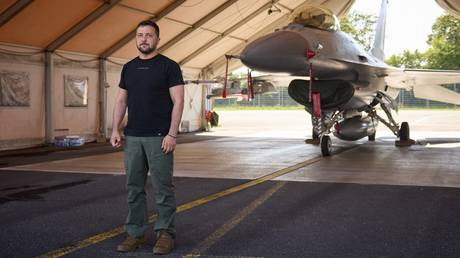
The 50-year-old jet won’t turn the tide of the conflict in Kiev’s favor, but it profits its partners to keep pretending
As the Western establishment media begrudgingly accepts, what many analysts have long predicted – that Kiev’s counteroffensive is a catastrophic failure – it seems that Ukrainian President Vladimir Zelensky hasn’t gotten the memo.
He seems adamant that the mercurial F-16 fighter jet is the missing link required to spur his depleted military to victory against Russia. There is, however, a little problem with his thesis – there’s more than one, actually, but let’s start with the most obvious.
Even as Ukraine’s long-awaited, much-hyped, but now obviously failed counteroffensive grinds to a bloody and costly halt, it seems the pro-war enthusiasts in the West and their proxies in Kiev still believe that the F-16, an American fighter jet that first took to the skies nearly 50 years ago, can somehow save the day for Zelensky and his NATO handlers. But at the same time trouble seems to be brewing in paradise as the Western media, which has thus far played such a pivotal role in overhyping Kiev’s military capabilities, is now less than convinced that this aging American castoff can play anything close to a defining role in NATO’s stalling proxy war against Russia.
While Ukrainian casualties mount, Kiev still insists that its long-telegraphed counteroffensive is indeed “inching forward,” even though the stark reality is that only a tiny fraction of its stated goals have been achieved with vast amounts of Western materiel lost in the process. This all comes as Ukraine’s Western “partners,” who were previously so eager to “stand with Ukraine as long as it takes,” become less and less absolutist in their convictions. A coming winter, domestic woes, failed sanctions against Russia, and endless demands from Kiev to replace cash and equipment are all starting to wear on an increasingly nervous NATO. Zelensky’s failed offensive is now accelerating the natural progression of war weariness in the West, where once there was supreme, almost absolute, confidence that Ukraine’s heroic warriors would easily cast out the barbarous Russian invaders. It seems that now even the spokesman for Ukraine’s decimated air force, Yury Ignat, seems to accept that when it comes to actually defeating the huge Russian military machine, talk is very cheap. Ignat recently revealed that Ukrainian fighters can barely take off before they are targeted by an overwhelming array of Russian fighters and anti-aircraft systems. He also noted that Russian fighters are far more advanced and have a far longer combat range, something the Ukrainian president conveniently forgets to mention during his awkward cockpit photo ops in Denmark, where he yet again peddles the now-tired promise of the latest in a long line of “game changers” – all of which the Russian Army has proven to be anything but. All they change, sadly, is the length of the conflict and the number of Ukrainian men doomed to die fighting it.
While the NATO architects of this conflict are of course eager to dangle the carrot of F-16 deployment to an increasingly desperate Kiev, in reality the fighters are highly unlikely ever to see service in the skies above Ukraine, at least not while the conflict is in its current active phase. Only three “partner” countries (Norway, Denmark, and the Netherlands) have promised to hand a few of the fighters over to Kiev, and there are still massive logistical issues that would need to be ironed out before they could even land in Ukraine, let alone take off and enter combat.
It’s important to pay attention to where information about the reality of the F-16s’ potential deployment comes from. That’s why, when US Joint Chiefs of Staff Chair General Mark Milley warned that the planes won’t act as a “magic weapon” for Ukraine, many sober, nonaligned analysts took note. Milley pulled no punches as he tried to pour some cold water on Kiev’s expectations regarding the aging jet. “The Russians have 1,000 fourth-generation fighters,” said the general following a meeting of the multinational Ukraine Defense Contact Group in May. “If you’re gonna contest Russia in the air, you’re gonna need a substantial amount of fourth- and fifth-generation fighters, so if you look at the cost curve and do the analysis, the smartest thing to have done is exactly what we did do, which is provide a significant amount of integrated air defenses to cover the battlespace and deny the Russians the airspace.”
It seems that when a message isn’t playing to the narrative, the message gets conveniently shelved. General Milley’s comments are a sobering reminder of the undeniable battlefield reality, a truth routinely lost on Zelensky and company as the PR prerogative trumps the strategic reality on the ground yet again in Kiev.
Interestingly, Milley also addressed the huge costs associated with the provision of the F-16 to Ukraine: “If you look at the F-16, ten F-16s cost a billion dollars, the sustainment cost [is]another billion dollars, so you’re talking about $2 billion for ten aircraft.” He also suggested that if the cash sent to Ukraine so far had been spent on this type of weapon, not on artillery and air defense, Kiev would be in a much worse position than it is today. “There are no magic weapons in war, F-16s are not and neither is anything else,” he said. Of course, the blunt and, from a Ukrainian point of view, dismal reality is that Ukraine’s dilapidated infrastructure can’t even begin to accommodate these complex jets. Ukraine has no appropriate training facilities on its soil, and a mere eight Ukrainian pilots have begun training in Denmark. More are set to start the process in the US in October, but it would take years of preparation to have adequate pilots in any meaningful numbers. Another fact glossed over by Kiev is that the F-16s, should they ever get as far as Ukraine, will need a lot of ground maintenance infrastructure and highly complex logistical support, all of which would have to be deployed into what is essentially a war zone. No one on the NATO team seems to want to address the minor detail that the Russian Air Force will be hunting both the jets and the infrastructure from day one – another inconvenient reality conveniently ignored.
While it now seems obvious that the actual provision of F-16s to Ukraine is probably nothing more than a far-off mirage, many now see the jet in the context where it actually belongs – as another NATO castoff cynically dumped into Ukraine by Washington’s allies on the promise of higher-tech replacements by a cash-hungry Uncle Sam. But given the dire performance of Western hardware on the battlefield so far, it will surprise no one if the US ultimately cans the entire project rather than suffer the embarrassing, and inevitable, images of burning F-16s joining those of American Bradleys and MaxxPros in the fields of southern and eastern Ukraine.
So as the increasingly uneasy architects of this catastrophic conflict finally begin to accept that this all only ends one way, they’re likely to string Kiev along for as long as possible when it comes to the illusive F-16s, just like they’ve been doing with their promises of EU and NATO membership. Let’s not forget, it was those very same hollow promises that set Ukraine on the road to this devastating conflict with Russia, a conflict only the very foolish could now believe will be won with a handful of 50-year-old fighter jets.



